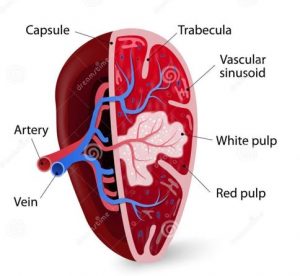The Spleen

The spleen is the largest organ in the lymphatic system – it is smaller in size than the liver, but larger than a kidney. It is located near the stomach, in the left forward part of the abdomen and is attached to the stomach via small blood vessels. The exact location of the spleen depends upon its size and shape, and is affected by the size of the surrounding organs, such as the fullness of the stomach. The spleen is a dark red organ that is shaped somewhat like a tongue (or a slipper) – it is considerably longer than it is wide, and slightly constricted in the middle. It is covered by a tough capsule of fibrous tissue. Blood vessels enter and exit at one end, the “pedicle”.
The spleen is a very vascular organ, full of blood vessels and blood storage areas. The main jobs of the spleen are:
To act as a blood storage reservoir (about 10-20% of the total blood volume) for both red blood cells and platelets. The body has the ability to contract the spleen suddenly if additional red blood cells are needed in the bloodstream.
To make red blood cells (hematopoiesis) – it is the major site outside the bone marrow where red blood cells are made.
To filter the blood – the spleen removes old or abnormal blood cells and particles from the blood.
To trap and remove old cells, bacteria and foreign proteins from the circulation (phagocytosis)
To fight infection as part of the immune system.
All blood, at some point, gets filtered through the spleen. As the organ is directly connected to blood circulation, it responds faster than other lymph nodes to blood-born antigens.
Although it has several important functions, dogs can manage to live a normal life without their spleen if it has to be removed (more commonly due to the spleen rupturing after a road traffic accident or from it developing a tumour). This is because every function of the spleen is also carried out elsewhere in the body (although not necessarily as efficiently). However life-threatening complications may result if the organ ruptures.
The internal structure of the spleen consists of:
Red pulp – this contains arterial capillaries and small venous vessels, and is the area for red blood cell formation and storage and for the trapping of the antigen immune proteins.
White pulp – this consists mainly of T and B lymphocytes, and is an area of special immune response cells.
Marginal zone – an area that separates the white and red pulp and helps to filter the blood.
The spleen is divided into chambers or lobules – each chamber is similar to an individual lymph node in that it helps filter the blood through the spleen.
The spleen can be a site of primary disease, affecting only that organ, or it may become involved in a disease that affects many parts of the body. Dogs are generally prone to enlargement of the spleen, or tumours and other growths. Common diseases of the spleen are:
Enlargement of the spleen associated with immune system disorders, certain anaemias, massive production of red blood cells, and certain infections. It can also be affected by the administration of some drugs.
Development of hematomas or blood clots from trauma, bleeding disorders or bleeding tumours.
Twisting or torsion of the spleen may accompany stomach dilation and torsion, and the spleen can also become enlarged and congested from twisting of the splenic blood vessels.
Benign tumours, such as hemangioma.
Malignant tumours / cancers, such as hemangiosarcoma – this is a common cancer in middle aged to elderly dogs, especially large breed dogs.
Other malignant tumours, such as mast cell tumours, multiple myeloma and lumphosarcoma.
